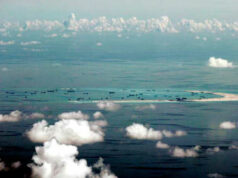US says bilateral training with Japan conducted in South China Sea
THE United States and Japan on Friday, Aug. 31, conducted a “bilateral training…while underway in the South China Sea,” the US Navy said in a statement that day.
Taking part in the exercise were units from the Ronald Reagan Strike Group of the US and the Japan Maritime Self-Defense Force, Escort Flotilla 4 Battle Group. According to the statement, “the two maritime forces sailed in formation, participated in replenishment-at-sea training, exchanged Naval Liaison Officers and practiced maneuvering procedures.
Rear Adm. Karl O. Thomas, Commander, Task Force 70, and CTF 70 personnel met with JMSDF Rear Adm. Tatsuya Fukuda, Commander, Escort Flotilla 4, at the JS Kaga.
On Saturday, the ship docked at Alava Pier in Subic Bay, the Philippines’ Presidential News Desk said, adding that President Rodrigo R. Duterte himself had a tour of the ship before his meeting with Mr. Fukuda, as well as wtih Japanese Parliamentary Vice Minister of Defense Keitaro Ohno, and Japanese Ambassador to the Philippines Koji Haneda.
“The teamwork and professionalism I have experienced by both CTF 70 and JMSDF sailors during this training operation has truly demonstrated how seamlessly we can integrate with our Japanese allies,” Mr. Thomas was quoted in the statement as saying of Friday’s bilateral training.
He added: “Training with Escort Flotilla 4 was a fantastic opportunity to bring together our strike group with the JMSDF battle group and further the interoperability we have been building for years between our forces.”
Ronald Reagan Strike Group units included in the bilateral training were the aircraft carrier USS Ronald Reagan (CVN 76), the Ticonderoga-class guided-missile cruiser USS Antietam (CG 54) and the Arleigh Burke-class guided-missile destroyer USS Milius (DDG 69).
Escort Flotilla 4 Battle Group units included the helicopter destroyer JS Kaga (DDH 184), the Murasame-class destroyer JS Inazuma (DD 105) and the Akizuki-class destroyer JS Suzutsuki (DD 117).
The Ronald Reagan Strike Group is forward-deployed to the US 7th Fleet area of operations in support of security and stability in the Indo-Pacific region, the US Navy’s statement also said. — with Arjay L. Balinbin



